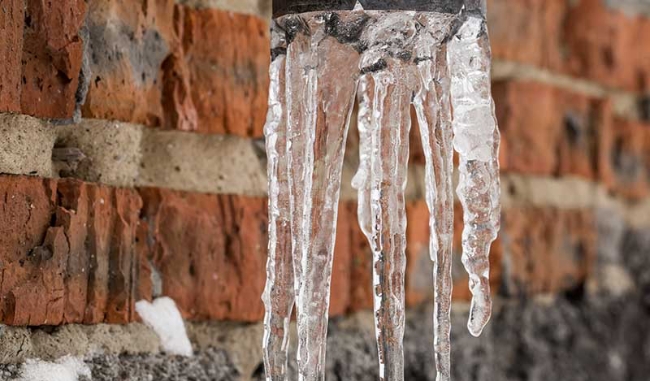Essential Tips for Preventing Frozen Plumbing in Cold Weather Seasons
Essential Tips for Preventing Frozen Plumbing in Cold Weather Seasons
Blog Article
The content which follows relating to How to prepare your home plumbing for winter weather is quite compelling. Give it a try and draw your own assumptions.
:strip_icc()/snow-outdoor-faucet-pipes-4af65d1e5e904fb1aa7bf74071fe5d89.jpg)
Cold weather can wreak havoc on your plumbing, specifically by freezing pipes. Below's exactly how to stop it from occurring and what to do if it does.
Intro
As temperatures decline, the risk of icy pipelines increases, possibly causing costly repairs and water damages. Understanding just how to prevent frozen pipes is vital for homeowners in cold climates.
Avoidance Tips
Shielding susceptible pipelines
Wrap pipes in insulation sleeves or use heat tape to safeguard them from freezing temperatures. Focus on pipelines in unheated or external locations of the home.
Heating methods
Maintain indoor rooms appropriately heated up, specifically areas with plumbing. Open cupboard doors to permit cozy air to circulate around pipes under sinks.
How to determine frozen pipes
Look for decreased water flow from faucets, unusual odors or sounds from pipelines, and visible frost on subjected pipes.
Long-Term Solutions
Structural adjustments
Consider rerouting pipes far from outside walls or unheated areas. Include additional insulation to attics, basements, and crawl spaces.
Updating insulation
Purchase top quality insulation for pipelines, attics, and wall surfaces. Correct insulation assists maintain regular temperatures and decreases the threat of frozen pipelines.
Safeguarding Outdoor Plumbing
Garden tubes and outdoor faucets
Separate and drain garden pipes prior to winter. Mount frost-proof faucets or cover outside taps with shielded caps.
Understanding Icy Pipelines
What causes pipes to ice up?
Pipes freeze when subjected to temperature levels listed below 32 ° F (0 ° C) for expanded durations. As water inside the pipelines ices up, it increases, taxing the pipeline wall surfaces and possibly causing them to break.
Risks and damages
Frozen pipelines can cause water system interruptions, building damage, and expensive repair services. Burst pipelines can flooding homes and trigger extensive structural damage.
Indicators of Frozen Piping
Recognizing frozen pipelines early can stop them from breaking.
What to Do If Your Pipes Freeze
Immediate activities to take
If you presume icy pipelines, maintain faucets open up to ease pressure as the ice melts. Use a hairdryer or towels taken in warm water to thaw pipes slowly.
Final thought
Avoiding frozen pipelines requires proactive actions and fast responses. By recognizing the reasons, indications, and safety nets, house owners can protect their pipes during winter.
5 Ways to Prevent Frozen Pipes
Drain Outdoor Faucets and Disconnect Hoses
First, close the shut-off valve that controls the flow of water in the pipe to your outdoor faucet. Then, head outside to disconnect and drain your hose and open the outdoor faucet to allow the water to completely drain out of the line. Turn off the faucet when done. Finally, head back to the shut-off valve and drain the remaining water inside the pipe into a bucket or container. Additionally, if you have a home irrigation system, you should consider hiring an expert to clear the system of water each year.
Insulate Pipes
One of the best and most cost-effective methods for preventing frozen water pipes is to wrap your pipes with insulation. This is especially important for areas in your home that aren’t exposed to heat, such as an attic. We suggest using foam sleeves, which can typically be found at your local hardware store.
Keep Heat Running at 65
Your pipes are located inside your walls, and the temperature there is much colder than the rest of the house. To prevent your pipes from freezing, The Insurance Information Institute suggests that you keep your home heated to at least 65 degrees, even when traveling. You may want to invest in smart devices that can keep an eye on the temperature in your home while you’re away.
Leave Water Dripping
Moving water — even a small trickle — can prevent ice from forming inside your pipes. When freezing temps are imminent, start a drip of water from all faucets that serve exposed pipes. Leaving a few faucets running will also help relieve pressure inside the pipes and help prevent a rupture if the water inside freezes.
Open Cupboard Doors
Warm your kitchen and bathroom pipes by opening cupboards and vanities. You should also leave your interior doors ajar to help warm air circulate evenly throughout your home.

I hope you enjoyed our excerpt on How To Avoid Freezing Pipes. Many thanks for taking the time to read through our post. I beg you set aside a second to promote this page if you enjoyed it. Many thanks for taking the time to read it.
Call Today Report this page